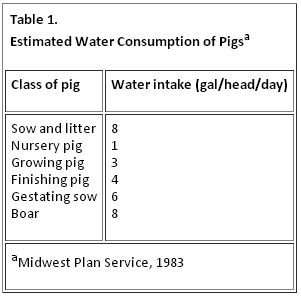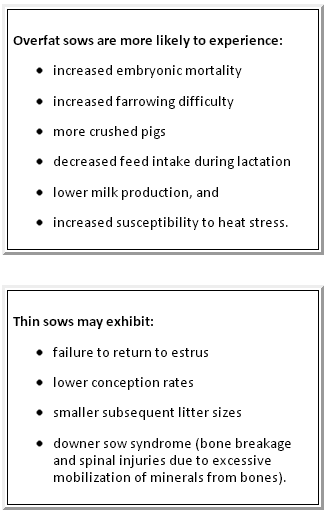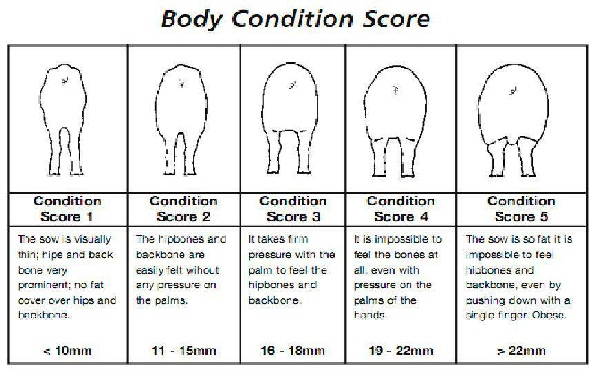


Feed and Water
And
Miscellaneous Information
The following information is not from Surin Farm and, I am sorry to say, I do not know exactly where I found it. I think it comes from the University of Minnesota. The information is great so I want to include albeit I cannot give credit to the owner.
Importance of Water
While much attention focuses on feed intake and formulation of diets, water is the most important nutrient to the pig. Water makes up about 80% of the pig's body at birth and 50% of the market hog's body. A pig housed in thermo neutral conditions will consume 2 to 3 lb of water for every pound of dry feed consumed. Under heat stress or during lactation this may increase to 4 or 5 lb of water for every lb of feed. Estimated water consumption for various classes of pigs is listed in Table 1.

Estimating Nutrient Needs at Each Production Stage
Feeding Gestating Sows
The primary objective for nutrition of gestating sows is precise control of weight gain and body condition while supporting optimal fetal development. Sows must be limit-fed to minimize excessive weight gain.
Measuring Feed Intake for Gestating Sows
Scoop method—Fill a scoop to a designated level. Weigh the contents of the scoop and record the weight. Repeat this procedure several times to determine an average amount of feed the scoop will hold. Count and record the number of scoops given to each animal at feeding. Periodically recheck the weight of feed the scoop will hold. Changes in density of feed reduce the accuracy of this method, but it is better than not measuring feed intake at all. Check calibration of automatic feed drop systems.
Producers commonly feed a gestation diet at about 4–6 lb/day to sows under most environmental conditions. This quantity of feed per day is only a target and the actual amount fed should be varied according to individual animals and situations. Reducing daily feed allowance to less than 3 lb/hd may cause inadequate intake of vitamins and minerals with typical gestation diets.
Size of Sow
Larger, heavier animals have higher maintenance requirements than smaller, lighter animals. Energy requirements increase about 200 kcal ME for each 20 lb increase in body weight.
Housing and Feeding Method
When breeding stock are housed and fed in groups, they require about 15% more feed than individually fed animals because timid sows will not consume their full share.
Environmental Temperature
Sows housed at temperatures below their lower critical temperature require more feed to maintain body temperature than sows housed in a warm environment. For every 20 degrees F below 60 degrees F, feed allowance should increase l lb. This rule of thumb applies to the temperature sensed by the animal, which is not necessarily the same as the thermometer reading.
Body Condition
Thin animals have less fat and insulation and require more feed than animals in good body condition to maintain body temperature when housed in low environmental temperatures.
The consequences of undesirable body condition for sows include increased culling rate, increased numbers of gilts in the sow herd and decreased pigs/sows per year.

There are two methods to evaluate a gestation feeding program:
1) Condition scoring. This method combines visual appraisal and estimated back fat to arrive at a number from 1 to 5. The desirable condition score at farrowing is 3. Daily feed offered should be adjusted if average score is above or below 3 (see Figure 2).
Figure 2. Condition Scores of Sows (Patience and Thacker, 1989.)

For younger sows and fatter genotypes, last rib backfat measurements may be higher.
2) Weigh animals. Weight gains depend on environmental conditions, genetics, and amount of weight lost during the previous lactation.
---------------------------
Chapter 7, in Swine Nutrition by E.R. Miller, D.E. Ullrey and A.J. Lewis.
In general, lactation diets for highly productive sows should contain ingredients that are concentrated sources of energy and protein such as corn and soybean meal. Feed ingredients high in moisture or fiber content such as beet pulp, alfalfa hay, oats or wheat bran dilute the nutrient content of the diet and may limit nutrient intake. Recently, researchers have studied the balance of essential amino acids in diets for lactating sows. Early studies would suggest that branched chain amino acid (i.e., valine) concentration of many diets formulated for high producing sows may be too low to maximize milk production. Additional studies are needed to verify this observation and to further clarify the appropriate pattern of essential amino acids before recommendations on branched chain amino acid concentration of lactating sow diets can be offered with confidence.
Feeding Starter Pigs
The primary objective for nutrition of weanling pigs is to optimize growth performance during the first few weeks after weaning. The increasing practice of weaning pigs at a young age (10–21 days) has resulted in problems with post weaning lag seen as decreased gains, low feed intake and increased morbidity (sickness) and mortality (death) on many swine farms. Environment, health, management practices and nutrition impact the success of a weaning program. Environment (temperature, air quality, pen and equipment characteristics) is the most critical factor. After a satisfactory environment has been provided, nutrition is the next most critical factor.
In addition to other stresses at weaning, the change from liquid sow's milk to a dry starter diet is quite a challenge for the young pig. Information on the characteristics and level of nutrients in sow's milk and the ability of pigs to utilize various nutrients from commonly available feedstuffs has been used to formulate diets that promote satisfactory performance of early weaned pigs.
Dried milk products contain forms of protein (casein) and energy (lactose) that are highly digestible by the young pig. Pigs weaned at a young age ( <21 days) are very sensitive to anti-nutritional factors present in conventionally processed soybean meal. Thus, the level of soybean meal fed to these pigs should be limited. These young pigs develop a transient hypersensitivity response (allergy) to soybean proteins which increases incidence of diarrhea and reduces growth rate (post weaning lag). After about 2 weeks, pigs become tolerant of soybean protein, the hypersensitivity response wanes and growth performance improves. Complex diets containing small amounts of soybean protein are fed to newly weaned pigs to avoid post weaning lag.
Diets containing high levels of dried milk products, specially processed soybean products, animal by-products (i.e., spray-dried porcine plasma, spray-dried blood meal, fish meal), and highly digestible carbohydrate sources (i.e., oat groats) are often called "complex starter diets" in contrast to "simple" corn-soybean meal starter diets. Quality of these specialized feed ingredients varies greatly among suppliers. Use only high quality ingredients in complex starter diets even though they are more expensive than the same ingredients of lower quality. A list of ingredient specifications is beyond the scope of this publication. Contact a competent nutritionist for advice concerning quality of specialized feed ingredients for starter pig diets. Feeding complex starter diets to pigs weaned at less than 4 weeks of age results in significantly improved performance compared to simple diets. In some experiments, feeding complex starter diets containing high levels of milk products has resulted in improved subsequent performance during the grower and finisher phases of production.
As the pig grows, its digestive system can better utilize protein and energy from plant sources and becomes less sensitive to antinutritional factors. Thus, the performance boost gained by feeding complex diets instead of simple diets decreases over time. Furthermore, simple diets are considerably less expensive.
Feeding Grower-Finisher Pigs
Since 75% of total feed used in a farrow-finish operation is consumed in the grower-finisher phase, nutritional accuracy in this phase has a substantial economic impact. Due to the quantity of feed consumed, the impact of amino acids on lean growth, the cost of adding amino acid sources to the diet and increased demand for leaner pork, emphasis is being placed on more accurately defining amino acid requirements for grower-finisher pigs based on genotype, sex and stage of growth. However, ensuring an adequate quantity of energy intake is equally critical to optimize lean growth rate and efficiency.
Genotype
Research at Purdue University has indicated that lean growth potential is highly variable among genotypes commonly found in the pork industry. Faster growth rates, more efficient feed conversion and increased carcass leanness create economic advantages for producing high lean growth genotype pigs. Differences in lean growth potential result in differences in amino acid requirements, especially lysine. The lean growth rates of pigs of various genotypes can be identified and used to determine their protein and lysine requirements.
Sex
Barrows eat more feed and grow faster than gilts. Gilts have less fat, more muscle, a higher carcass yield and better feed conversion than barrows at a similar body weight. Thus, gilts require higher dietary concentrations of amino acids to promote optimal lean gain than do barrows. When penned together, barrows and gilts are often fed a level of protein and lysine intermediate between the requirements of the two sexes. Consequently, excess protein is fed to barrows resulting in increased cost/lb of gain. Gilts are deprived of protein resulting in reduced growth rate and decreased carcass lean.
Customized diets can be formulated for the requirements of barrows and gilts, but they must be penned and fed separately. If feeding systems and facilities can be inexpensively modified to use separate diets for barrows and gilts, separate sex feeding will generally increase profitability when pigs are marketed on a lean value pricing scheme. New swine facilities should be constructed to accommodate separate sex feeding to allow producers to tailor diets for barrows and gilts. Differences between barrows and gilts in feed consumption and carcass composition begin to appear above 40 lb body weight and become significantly greater as pigs reach market weight. Sexes can be separated when moved into the nursery or grower facilities.
Boars gain faster, are more efficient and have less backfat than gilts and barrows at a given weight; consequently, growing boars have greater amino acid requirements than barrows and gilts. Developing boars should be full-fed up to about 240 lb to allow assessment of rate of gain and backfat depth for genetic selection programs. Boars can then be limit-fed as outlined in the section on feeding boars.
Stage of Growth
Rate of muscle growth decreases and maintenance requirement increases with increasing body weight. Thus, amino acid requirements also change with stage of growth. Altering dietary lysine levels to match changes in feed intake and nutrient requirements along the pig's growth curve improves the efficiency of amino acid use and can reduce production cost.
The frequency with which lysine levels are altered in the grower-finisher phase depends on knowledge of amino acid requirements and the ability to handle multiple diets in your feeding system. Some producers will have the information and feeding system flexibility to change diet formulations every time a feed bin is filled. This gives those producers a distinct competitive advantage.
Two critical pieces of information are necessary to fine-tune diets for grower-finisher pigs: growth rate and feed disappearance (intake). There are two general methods of recording this information. The inventory method is the simplest method but provides limited information. The group method is more complex and provides more detailed information.
Measuring growth rate—The inventory method requires producers to record the weight of all pigs as they enter the building, number and weight of dead pigs and dates and weights of pigs marketed.
ADG = [ (wt. out – wt. in) + wt. gain of pigs remaining in building] ÷ Pig-days*
*Pig-days = no of pigs x no of days of monitoring (inventory) period